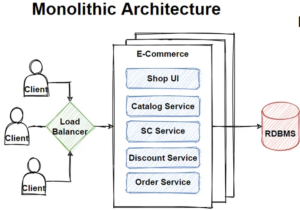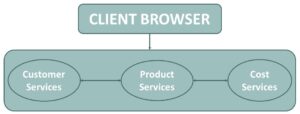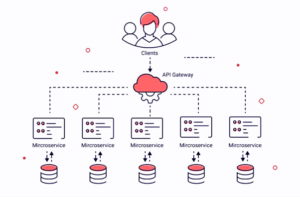Introduction
In the ever-evolving landscape of software development, choosing the right architectural approach is crucial for building robust and scalable applications. Two popular architectural styles that often come into consideration are Monolithic and Microservice. Both have their merits and trade-offs and understanding their differences is vital for making an informed decision that aligns with your project’s goals.
In this blog, we will explore both architecture’s characteristics, advantages, and challenges to help you choose the right path for your application.
Monolithic Architecture: The Legacy Approach
In a Monolithic architecture, all components of an application are bundled together into a single, unified unit. This means that the application’s front-end, back-end, and databases are tightly coupled within a single codebase. While this approach was common in the past and still exists in many legacy systems, it’s essential to be aware of its strengths and limitations.

A monolithic architecture has its advantages, which is why many applications are still built using this development paradigm. First, monolithic programs can perform better than modular applications. It can also be easier to test and debug because fewer test variables and scenarios work with fewer factors.
Advantages of Monolithic Architecture
- Simplicity: Building and deploying a monolithic application is generally straightforward since everything is contained within one codebase.
- Easier Testing and Debugging: With a single codebase, testing, and debugging become more straightforward, as there are no complexities related to distributed systems and no network calls between separate services.
- Performance: Monolithic applications often exhibit better performance compared to distributed systems due to reduced network overhead.
- Comprehensive Features: Since all components are in one place, it’s easier to access and utilize the full range of features without worrying about integration.
Understanding monolithic architecture with an example:
Let’s take an example of an e-commerce site:

As you can see in the example all the services provided by the application (Customer Services, Cost Services, Product Services) are directly connected. So, if we want to change in code or something we must change in all the services as well.
Challenges of Monolithic Architecture
► Scalability: Scaling a monolithic application can be challenging, as it requires scaling the entire system even if only one component needs additional resources.
► Maintainability: As the application grows, the codebase can become unwieldy and difficult to maintain, leading to longer development cycles.
► Limited technology diversity: All components of a monolithic application must use the same technology stack, limiting your ability to adopt the best tool for each specific task.
► Agility and Flexibility: Monolithic architectures can hinder agile development and continuous deployment, as changes to one component may require rebuilding and redeploying the entire application.
Microservice Architecture
Microservices, on the other hand, is an architectural style that emphasizes breaking down the application into small, independent services, each with its own specific functionality. These services communicate through lightweight APIs, and they can be developed, deployed, and scaled independently.

Micro service Architecture supports modular applications where any single module in a system, such as a microservice, can be changed independently without affecting the other parts of the program and without creating unanticipated changes within other elements.
Advantages of Microservice Architecture
- Scalability: With microservices, you can scale individual services independently, allowing better resource utilization and cost efficiency.
- Modularity and flexibility: Each microservice is separate, allowing developers to work on different parts of the application simultaneously and use the most suitable technology for each service.
- Fault isolation: If one microservice fails, the entire application doesn’t collapse since other services can continue to operate independently.
- Agile Development: Microservices facilitate agile development practices, enabling teams to work on different services simultaneously without interfering with each other’s work.
Examples of Microservices:
Here are some of the real-life examples of applications that use microservices are:
- Amazon – When microservice initially emerged, Amazon was the first platform to deconstruct its monolithic application into smaller components, by adopting microservice. The functionality of the site has increased because of its ability to modify specific resources and features.
- Uber – The transition for Uber from a monolithic nature to a microservice went smoothly. The number of webpage views and searches developed significantly when using microservice architecture.
Challenges of Microservice Architecture
► Complexity: Microservices bring added complexity due to the distributed nature of the system. Proper design and implementation are crucial to avoid potential pitfalls. Managing a distributed system with multiple services requires robust communication, monitoring, and error-handling mechanisms.
► Deployment and Integration: To ensure seamless integration and compatibility, it may take more work to deploy and manage various services.
► Communication overhead: Communication between services can introduce latency and performance bottlenecks, especially if not properly optimized.
► DevOps Alignment: Microservices adoption requires a strong DevOps culture to effectively manage and orchestrate diverse services in a continuous delivery environment.
Choosing between Monolithic vs. Microservice Architecture:
The decision between Monolithic and Microservice architecture depends on various factors, including the project’s size, the team’s expertise, scalability requirements, and long-term goals.
Choose Monolithic if:
-
- Your application is small to medium-sized, and complexity is low.
- The team lacks experience with distributed systems.
- Quick development and deployment are top priorities.
Choose Microservice if:
-
- Your application is large and complex, with specific components that require independent scalability.
- Your team has experience with distributed systems and is comfortable handling the added complexity.
- You expect rapid growth and need to scale individual components efficiently.
Conclusion:
In summary, both Monolithic and Microservice architectures have their place in the software development world. The key lies in understanding the unique needs and goals of your application. A monolithic approach may suit simple, smaller projects with lower scalability demands. While microservices can empower large, complex systems with high scalability requirements. Always consider the trade-offs and select the architecture that aligns best with your project’s current and future needs. By making a well-informed choice, you set the foundation for a successful and future-proof application.
References:
https://www.geeksforgeeks.org/microservices/
Medium – Design Microservice Architecture
Happy Reading!!


Useful post. Thank you for sharing Pooja.